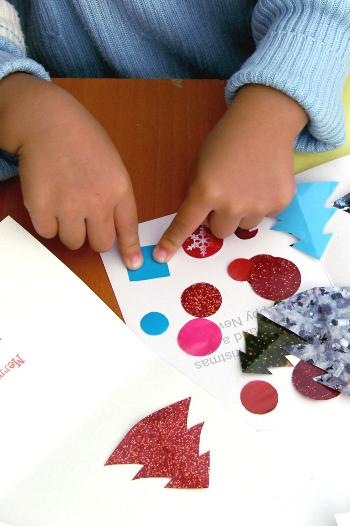Making Christmas cards
Duration/age

We often send cards to family and friends at Christmas time. Instead of buying cards this year you could ask your child to help you make some.
Talk with your child about the different types of cards you can get and what they are used for. There are table cards that help people to know where to sit, cards that are tags for presents and cards to write in. What kind of cards will you make?
We need to make cards to label the presents, and cards to send to Nana and Papa in England.
Once you have worked out the type of card you will make, talk about what you will need. Explain to your child that the more writing the card has the bigger it will need to be.
We could trace around the Christmas tree biscuit cutter for the gift tags. We only need enough space to write a person’s name on it.
I am going to write a long message to Uncle Sum in India so we will need to make a bigger card for all the writing.
Materials you will need
- Paper
- Glue
- Glitter
- Stickers
- Scissors
- Textas
- Card
Alternative tools
- Crayons
- Envelopes
- Cardboard
- Magazines
- Wrapping paper
- Stamps and stamp pad
- Family photos
Skills this activity improves
Why does this matter?
By exploring the picture, words and images on the card children are learning that language can be shared in different ways. Often we think of language as only spoken or written not as a picture or an image that can help us to understand the feelings and emotions of the person giving the card. As children create their own writing, pictures and symbols they are learning that we can communicate through writing and drawing. Children learn that letters make up words, and that words make up sentences to tell a story.
As they write and develop images they are also experimenting with how and where to place the image and words on the page. By experimenting with placement and organisation of the words and images they are exploring how to change the mood or effect of the message they are creating.
What does this lead to?
When children create they are developing language to describe what they know and have seen. As they use language with their pictures or experiment with colour, shape and symbols they are developing an understanding that pictures can tell a story. They can change the story by using different images, colours or placements on the page. By experimenting with changing the design children are learning to add or change the emotion of the story.
As they combine writing, drawing and symbols they are gaining an understanding of different ways of communicating and that writing conveys meaning. By writing in a card, children learn that words can be written and that this communicates a message to another person. Children are learning the permanence of written communication as compared to spoken communication.
Language to use
- Letter, word, sentence
- Envelope, stamp
- Writing, drawing
- Post, postie, letterbox, post-office box, delivery
- Postcode, address
Questions to use
- Who is the card for?
- What picture could we put on the front?
- What do we need to write inside the card?
- Where do we go to post a letter?
Useful tips
- When writing words for children to copy use lowercase or small letters.
- Encourage your child to write in your home language.
- You might also like to take a look at the Writing a letter or card activity.
- Remember to talk to your child in your home language.
More ideas
- Search online for different types of cards that you can make.
- Try making an E-card to send to family members interstate or overseas.
- Take photos of the family to include on the card.
Variation by age
Three to five year olds
- Write the name of each family member under their photo. This will help if your child wants to have a go at writing different names.
- Make a handprint on the front of the card.
- Write the words inside the card in pencil. Your child can then trace over the top of the words.
- Cut images and patterns from wrapping paper and magazines.
- Make a word model, or cloud, of Christmas words.
Questions to ask
- Does this card get posted or put on a present?
- What do the words tell us?
- Can you have words inside and outside the card?


